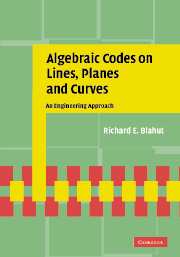Book contents
- Frontmatter
- Contents
- List of figures
- List of tables
- Preface
- Dedication
- 1 Sequences and the One-Dimensional Fourier Transform
- 2 The Fourier Transform and Cyclic Codes
- 3 The Many Decoding Algorithms for Reed–Solomon Codes
- 4 Within or Beyond the Packing Radius
- 5 Arrays and the Two-Dimensional Fourier Transform
- 6 The Fourier Transform and Bicyclic Codes
- 7 Arrays and the Algebra of Bivariate Polynomials
- 8 Computation of Minimal Bases
- 9 Curves, Surfaces, and Vector Spaces
- 10 Codes on Curves and Surfaces
- 11 Other Representations of Codes on Curves
- 12 The Many Decoding Algorithms for Codes on Curves
- Bibliography
- Index
7 - Arrays and the Algebra of Bivariate Polynomials
Published online by Cambridge University Press: 05 October 2009
- Frontmatter
- Contents
- List of figures
- List of tables
- Preface
- Dedication
- 1 Sequences and the One-Dimensional Fourier Transform
- 2 The Fourier Transform and Cyclic Codes
- 3 The Many Decoding Algorithms for Reed–Solomon Codes
- 4 Within or Beyond the Packing Radius
- 5 Arrays and the Two-Dimensional Fourier Transform
- 6 The Fourier Transform and Bicyclic Codes
- 7 Arrays and the Algebra of Bivariate Polynomials
- 8 Computation of Minimal Bases
- 9 Curves, Surfaces, and Vector Spaces
- 10 Codes on Curves and Surfaces
- 11 Other Representations of Codes on Curves
- 12 The Many Decoding Algorithms for Codes on Curves
- Bibliography
- Index
Summary
An array, υ = [υi′i″], defined as a doubly indexed set of elements from a given alphabet, was introduced in Chapter 5. There we studied the relationship between the two-dimensional array υ and its two-dimensional Fourier transform V. In this chapter, further properties of arrays will be developed by drawing material from the subject of commutative algebra, but enriching this material for our purposes and presenting some of it from an unconventional point of view.
The two-dimensional array υ can be represented by the bivariate polynomial υ(x, y), so we can study arrays by studying bivariate polynomials, which is the theme of this chapter. The polynomial notation provides us with a convenient way to describe an array. Many important computations involving arrays can be described in terms of the addition, subtraction, multiplication, and division of bivariate polynomials. Although n-dimensional arrays also can be studied as n-variate polynomials, in this book we shall treat only two-dimensional arrays and bivariate polynomials.
As the chapter develops, it will turn heavily toward the study of ideals, zeros of ideals, and the relationship between the number of zeros of an ideal and the degrees of the polynomials in any set of polynomials that generates the ideal. A well known statement of this kind is Bézout's theorem, which bounds the number of zeros of an ideal generated by two polynomials.
- Type
- Chapter
- Information
- Algebraic Codes on Lines, Planes, and CurvesAn Engineering Approach, pp. 277 - 346Publisher: Cambridge University PressPrint publication year: 2008



